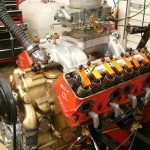Over the years I have heard a variety of numbers from 2% to 10% for what a point in compression ratio is worth in regards to horsepower output. The ten percent value obviously sounded a bit exaggerated while the two percent value sounded a bit on the small side. While dyno testing a variety of cylinder heads on the 312 dyno mule, the opportunity arose to determine exactly to what extent a compression ratio increase would have on the horsepower output. The dyno mule is the well used, tried and proven +060 over 312 with a Crower Monarch 238@050 camshaft ground on 110° lobe centers, a Mummert aluminum intake with a carb spacer, and a 750cfm Holley carb. The bottom end is still pretty much stock with ECZ rods and cast pistons that are sitting 0.025″ in the holes.
By lieu of the number of heads being tested, two different test scenarios presented themselves. One set of tests involved several pairs of heads with the same casting numbers that were simply milled different amounts. The other test was taking two sets of heads and dyno testing them in a before and after milling scenario to determine exactly how much compression ratio increases were worth on these particular pairs of heads. This later opportunity was obviously a more controlled test in that variations within the head castings themselves would be eliminated.
In collaboration with Tim McMaster who had already shipped several sets of heads as part of an extensive cylinder head test, it was decided to take two sets of those heads and dyno test these in a before and after milling test. The heads selected for this test are a pair of ECZ-C’s and a pair of C1TE-D’s. Both sets of heads were initially run on the test engine in their ‘as delivered’ state of mill. The heads were then milled and re-ran with everything else on the engine remaining the same. The headers being used are the Engine Masters Challenge headers with 1.75” tubes stepping up to 1.875” before going into a 3” merge collector. Mufflers are being used.
The C1TE-D heads have no port work on the intake sides but the exhaust sides have been ground on and opened up. The valves have been upgraded to 1.805” for the intakes and 1.600” for the exhausts. Initial combustion chamber volumes averaged 74.2cc providing an 8.41:1 static compression ratio. Peak horsepower in this format was 294.5 at 5400 rpm while peak torque was 334.6 lbs/ft at 3800 rpm. The heads are then cut ~0.045” which nets an average of 68.2cc for an 8.95:1 compression ratio. The peak horsepower jumps to 297.1 at 5100 rpm and the torque increases to 337.4 lbs/ft at 4400 rpm. That’s a 2.6 HP increase for a 0.54:1 increase in compression ratio or a 1.63% increase per compression point. The calculated horsepower increase for a full point of compression in this case would be 4.8HP.
The ECZ-C heads have had 1.900” intake and 1.600” exhaust valves installed. The intake and exhaust ports are still stock and have not been ground on. The combustion chamber volumes in the ‘before’ test are 74.0cc producing an 8.43:1 SCR (static compression ratio). The peak dyno numbers for these heads before milling are 289.5HP at 5400 rpm and the torque is 333.8 lbs/ft at 3900 rpm. The heads are then milled ~0.050” which gets the combustion chambers down to 67.3cc for a 9.04:1 SCR. The horsepower in this format jumps up to 295.4 at 5300 rpm while the torque increases to 338.5 lbs/ft at 3900 rpm. That’s a 5.9 HP increase for a compression ratio increase of 0.61:1 or 3.34% increase per point of compression. The calculated HP increase for a full compression point in this case would have been 9.7HP.
But now we get to discuss the other testing scenario. There are three sets of stock ECZ-C heads being run on the dyno mule and while the ports and valve sizes were stock, the pairs of heads had been milled differently. The compression ratios were 8.12, 8.6, & 9.0:1 with the HP values being 273, 280, & 288 respectively. As expected, there was a HP increase with each increase in compression ratio. In calculating the increase from 8.12:1 to 8.6:1, there is a 5.34% increase in HP per compression point. It’s found that the increase in CR from 8.6:1 to 9.0:1 produced a 7.14% HP increase per compression point. And in examining the overall increase from 8.12:1 to 9.0:1, there is a 6.24% HP increase per compression point. As mentioned earlier and because this was three different sets of heads being tested, there are still some other variables being introduced but the fact still remains that each compression ratio increase did net an increase in the horsepower output.
In the definitive milling test, there is an average of 2.6% HP increase per point of compression. In the less definitive test where three sets of heads with different combustion chamber volumes were tested, there is a 6.24% HP increase per point of compression. Regardless of which value you’d like to use, compression ratio increase is still the easiest and least expensive method in which to up the power output of your engine.
As always, this is food for thought. Until next time, happy Y motoring. Ted Eaton.
Click on pictures for a larger image
Originally published in Y-Block Magazine, Issue #106, Sep-Oct 2011, Vol. 18, No. 5


